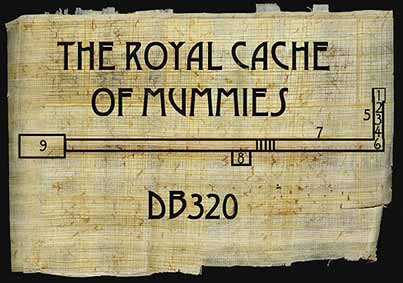 |
 |
 |
 |

The shaft into the tomb was about ten feet by eight and dropped forty feet into the solid rock, a small doorway then gave access to a low corridor which ran northwards (corridor 'B').
The corridor then turned 90 degrees (became slightly higher) and ran for a further 70 feet before reaching the first room (17 feet square) - 'piled high with coffins'.
The corridor continued another 100 feet before reaching the 21st dynasty 'family vault' - 16 feet high 20 feet long.
The dating of the burials:
The mummies in the cache were restored by High Priests of the 21st Dynasty, this were then finally interred into the family tomb of Pinudjem II as their final resting place. Dates on the coffins and dockets of the mummies show when they were restored and by whom.
An inscription at the entrance to the main corridor of the tomb also gives the inscription which dates the closing the tomb to Year 10 of King Siamun's reign, (also the date of the burial of Pinudjem I):
Inscription at the bottom of the well shaft, at the entrance to the tomb: 'Year 10, fourth month of the winter season, day 20, day of the burial of the Osiris, the High Priest of Amun-Re< King of the Gods, the great chief of the army, the leader, Pinudjem, by the divine father of Amun, the scribe of the army, the chief inspector, Nespekeshuty ; the prophet of Amun . . . enamun, the divine father of Amun, Wennefer; by the king's scribe in the place of truth, Bekenmut; the chief workman, Pediamun; the chief workman Amenmose; the divine father of Amun; the chief of secrets, Piedamun, the scribe of Enefenkhons'.
The final transfer of mummies from Inhapi's tomb (the staging post of the operation) to DB320 took place shortly after the interment of Djedptahiufankh or Nestanebtishru (early 22nd Dynasty).
